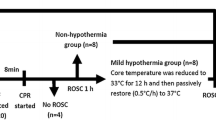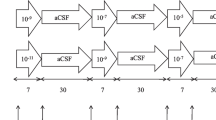Abstract
The effect of the lowering of body temperature on the responses of cerebral arteries was studied in anesthetized (urethane, 1000 mg/kg) male Wistar rats in conditions of hemodynamic stability and after pre-induced acute massive blood loss. Changes in the diameter of the pial arteries (initial diameter 10–40 µm) were evaluated via intravital microscopy in four experimental groups: without and with pre-induced blood loss (35% of the circulating blood volume), and in each group, at room temperature (22–23°C) and during gradually developing cold-water immersion hypothermia (12–13°C) until respiratory arrest. In the groups with pre-induced blood loss, respiratory arrest came about at room temperature after an average of 3 h with a decrease in body temperature to 32.4 ± 0.5°C, while during immersion cooling, it occurred after 2.5 h at 15.1 ± 0.8°C. In the groups without blood loss, respiratory arrest did not come about at room temperature for more than 3.5 h of observation, although rectal temperature decreased to 34.4 ± 0.2°C; during immersion cooling, respiratory arrest was observed after 3 h at a body temperature of 13.1 ± 0.3°C. During the lowering of body temperature, the rats of all experimental groups showed vasoconstriction. In the groups with blood loss, the reduction in the diameter of the pial vessels accounted for 10–15% of the initial immediately after blood withdrawal and more than 30% of that during subsequent immersion cooling. In rats without blood loss, the constriction of pial arteries during immersion cooling was significantly less. Thus, systemic hypothermia aggravates microcirculatory dysfunction induced by acute massive blood loss, suggesting an additive effect of hypothermia and hemorrhage on vasoconstrictor responses of the pial arteries in rats.




Similar content being viewed by others
REFERENCES
Kheirbek T, Kochanek A, Alam H (2009) Hypothermia in bleeding trauma: a friend or a foe? Scandinavian J Trauma, Resuscitation and Emergency Medicine. 17: 65. https://doi.org/10.1186/1757-7241-17-65
van Veelen M, Maeder B (2021) Hypothermia in Trauma. Int J Environ Res Public Health 18 (16): 8719. https://doi.org/10.3390/ijerph18168719
Burggraf M, Lendemans S, Waack I, Teloh J, Effenberger-Neidnicht K, Jäger M, Rohrig R (2019) Slow as compared to rapid rewarming after mild hypothermia improves survival in experimental shock. J Surg Res 236: 300–310. https://doi.org/10.1016/j.jss.2018.11.057
Eguillor J, Ferrara G, Edul V, Buscetti M, Canales H, Lattanzio B, Gatti L, Gutierrez F, Dubin A (2021) Effect of systemic hypothermia on microcirculation in conditions of hemodynamic stability and in hemorrhagic shock. Shock 55(5): 686–692. https://doi.org/10.1097/SHK.0000000000001616
Jiang S, Zhao Y, Zhao X (2013) Potential role of therapeutic hypothermia in the salvage of traumatic hemorrhagic shock. Critical Care 17: 318. https://doi.org/10.1186/cc12559
Shevelev OA, Petrova MV, Saidov SK, Khodorovich NA, Pradkhan P (2019) Neuroprotection mechanisms in cerebral Hypothermia (review). General Reanimatol 15(6): 94–114. https://doi.org/10.15360/1813-9779-2019-6-94-114
Gogol R, Hudziak D, Bis J, Mendrala K, Morkisz Ł, Podsiadło P, Kosiński S, Piątek J, Darocha T (2021) The role of deep hypothermia in cardiac. Int J Environ Res Public Health 18: 7061–7075. https://doi.org/10.3390/ijerph18137061
Tsarev AB (2017) Intraoperative hypothermia and volume of blood loss of patients with politrauma. Bul Probl Biol Med 141(4 Pt 3): 239–242. https://doi.org/10.29254/2077-4214-2017-4-3-141-239-242
Rosli D, Schnuriger B, Cadinas D, Haltmeier T (2020) The impact of accidental hypothermia on mortality in trauma patients overall and patients with traumatic brain injury specifically: a systematic review and meta-analysis. World J Surg 44 (12): 4106–4117. https://doi.org/10.1007/s00268-020-05750-5
Nishi K, Takasu A, Shinozaki H, Yamamoto K, Sakamoto T (2015) Hypothermia does not hasten death during uncontrolled hemorrhagic shock presenting as the “triad of death” in rats. Acute Med Surg 2(1): 29–34. https://doi.org/10.1002/ams2.60
Gong P, Zhao Sh, Wang J, Yang Z, Qian J, Wu X, Cahoon J, Tang W (2015) Mild hypothermia preserves cerebral cortex microcirculation after resuscitation in a rat model of cardiac arrest. Resuscitation 97: 109–114. https://doi.org/10.1016/j.resuscitation.2015.10.003
Crandall C, Rickards C, Johnson B (2019) Impact of environmental stressors on tolerance to hemorrhage in humans. Am J Physiol Regul Integr Comp Physiol 316: R88–R100. https://doi.org/10.1152/ajpregu.00235.2018
Shinichiro I, Takasu A, Sakamoto T (2010) Therapeutic mild hypothermia: effects on coagulopathy and survival in a rat hemorrhagic shock model. J Trauma 68(3): 669–675. https://doi.org/10.1097/TA.0b013e3181a0fbb3
George M, Mulier K, Beilman G (2010) Hypothermia is associated with improved outcomes in a porcine model of hemorrhagic shock. J Trauma 68(3): 662–668. https://doi.org/10.1097/TA.0b013e3181d3cbc0
Takasu A, Norio H, Sakamoto T, Okada Y (2002) Mild hypothermia prolongs the survival time during uncontrolled hemorrhagic shock in rats. Resuscitation 54(3): 303–309. https://doi.org/10.1016/s0300-9572(02)00148-x
Truse R, Smyk M, Schulz J, Herminghaus A, Weber A, Mettler-Altmann T, Bauer I, Picker O, Vollmer C (2019) Regional hypothermia improves gastric microcirculatory oxygenation during hemorrhage in dogs. PLoS One 14(12): e0226146. https://doi.org/10.1371/journal.pone.0226146
Frink M, Flohé S, van Griensven M, Mommsen P, Hildebrand F (2012) Facts and fiction: the impact of hypothermia on molecular mechanisms following major challenge. Mediators Inflamm 2012: 762840. https://doi.org/10.1155/2012/762840
Palmiere C, Bardy D, Letovanec I, Mangin P, Augsburger M, Ventura F, Iglesias K, Werner D (2013) Biochemical markers of fatal hypothermia. Forensic Sci Int 226(1–3): 54–61. https://doi.org/10.1016/j.forsciint.2012.12.007
Kursov SV, Nikonov VV., Skoroplit SM (2019) Blood loss. Emergency Medicine 96(1): 7–21. (In Russ).
Melnikova N (2020) Cerbral microcirculation during respiratory arrest in deep experimental rat hypothermia. J Stress Physiol Biochemistry 16(3): 126–131.
Grigor’ev EV, Lebedinsky KM, Schegolev AV, Bobovnik SV, Bulanov AYu, Zabolotskikh IB, Sinkov SV, Shen NP, Kornelyuk RA (2020) Resuscitation and intensive care in acute massive blood loss in adults (clinical guidelines). Russ J Anaesthesiol Reanimatol 1: 5–24. https://doi.org/10.17116/anaesthesiology20200115
Wu X, Stezoski J, Safar P, Nozari A, Tisheman S (2003) After spontaneous hypothermia during hemorrhagic shock, continuing mild hypothermia (34 degrees C) improves early but not late survival in rats. J Trauma 55(2): 308–316. https://doi.org/10.1097/01.TA.0000079366.23533.1E2
Alyabyev FV, Parfiryeva AM, Chesalov NP, Shamarin YA, Osipov AI (2008) Functional-morphologic changes of the heart in hypothermia. Siberian Med J 1(1): 68–71. (In Russ).
Murakami T, Yoshida T, Kurokochi A, Takamatsu K, Teranishi Yu, Shigeta K, Tamaki K, Morita S, Mizuno R, Oya M (2019) Accidental hypothermia treated by hemodialysis in the acute phase: three case reports and a review of the literature. Intern Med 58(18): 2743–2748. https://doi.org/10.2169/internalmedicine.1945-18
Bocharov MI (2015) Thermoregulation in cold environments. Report I Vestnik NAFU ser Med-Biol sci 1: 5–15. (In Russ).
Lutsenko DG (2008) Rat’s brain microhemocirculation after hypothermic effect. Probl of Cryobiol 18(1): 81–84. (In Russ).
Funding
This work was state budget funded and supported additionally by the State Program 47 SP “Scientific and Technological Development of the Russian Federation” (2019–2030).
Author information
Authors and Affiliations
Corresponding author
Ethics declarations
CONFLICT OF INTEREST
The author declares that she has no conflict of interest that might relate to the publication of this article.
Additional information
Translated by A. Polyanovsky
Russian Text © The Author(s), 2022, published in Zhurnal Evolyutsionnoi Biokhimii i Fiziologii, 2022, Vol. 58, No. 5, pp. 382–392https://doi.org/10.31857/S0044452922050084.
Rights and permissions
About this article
Cite this article
Melnikova, N.N. Effect of Systemic Hypothermia on Reactions of Pial Arteries to Acute Massive Blood Loss in Anesthetized Rats. J Evol Biochem Phys 58, 1310–1320 (2022). https://doi.org/10.1134/S0022093022050039
Received:
Revised:
Accepted:
Published:
Issue Date:
DOI: https://doi.org/10.1134/S0022093022050039




